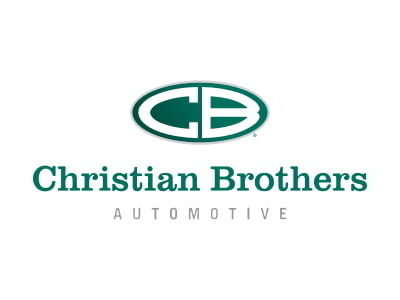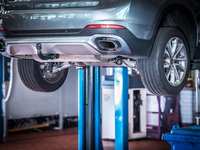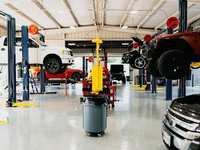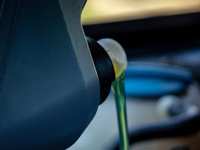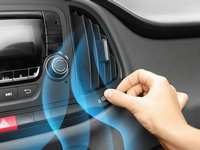Guidelines To Buying Your Teen The Best Car

Excitement builds in a teen as they grow closer to getting their license and owning their very own car. While the teen's idea of their first car may be a flashy sports car, parents might be happier with something more safety conscious – like an army tank.
WHAT SHOULD I CONSIDER WHEN BUYING MY TEEN THEIR FIRST CAR?
To help navigate this age-old dilemma and continue our ongoing series of creating the best tips for teens and other first-time drivers, Christian Brothers Automotive is here to guide you with helpful tips for choosing your teenager's first car.
We’ll start with the biggest question most of our customers are asking…
Should I Buy My Teen a New or Used Car?
The first thing to consider is if you should buy new or used. This can often be a difficult step, infamously known for creating drama between teens and parents. You'll want to find something that is safe, reliable, and economical. And, of course, one that won't launch your insurance premiums through the roof.
While buying a brand-new car might seem like an option with several advantages, a new car doesn't necessarily mean it's a good choice! A new car will protect against immediate breakdowns and repairs, but you're paying a high cost for those new car warranties.
When talking about buying new, it's important to note that new cars lose an average of 60% of their value in the first 5 years (some brands lose that much value in the first 3 years!). Additionally, they often come with high insurance premiums depending on the brand. The new car will probably never meet all your qualifications for a new driver. You’ll obtain the safety and reliability you’re looking for, but that may be all you obtain.
Our Advice? Buy Used.
While you would be skipping out on the warranty provided by the dealership, buying a certified pre-owned car can give you the advantages of a new car, like a warranty without the gigantic price tag. Plus, you'll be able to benefit from similar – or in some cases, better – financing plans than you would have found in a major dealership.
Buying used is also a great option if you’re skilled and comfortable doing light repairs on cars. If this is you, you might be able to buy an older car with cash and make small repairs to bring reliability and safety up to speed.
Speaking of reliability and safety…
What Safety Features Should a First Car Have?
There are three non-negotiable things your child's first car should have:
Antilock Brake System (ABS)
Antilock brakes have been standard on most cars for some time and are a vital safety element. When you slam on your brakes, have you noticed the car continues to move forward? That's because the ABS prevents the wheels from completely stopping or locking up. Even when the roads are slick due to rain or ice, you will be able to maintain braking and steering control.
Electronic Stability Control (ESC)
Electronic stability control (ESC) did not come standard on older cars, so it's important to check for this feature before buying used. ESC is an important safety element that prevents a car from rotating. This is crucial when a teen turns too fast or is driving during bad weather.
Side Airbags
Side airbags provide head protection during a side impact. If your teen is T-boned by another car, the side and side-curtain airbags will keep their head from hitting the side window. Side airbags are not standard, so you need to check for this feature before purchasing any car.
Be Sure to Complete the Proper Research
Want to hear some good news? You're already working on this step! Before ever stepping into a new or used car lot, make sure you do your homework. Have an idea of the type of vehicle you're looking for and the associated user reviews, safety checks, and awards given. This is the best way to find a safe and dependable car that will last them for the remainder of high school and well into their early adult years, when a new car payment or big car repairs may be difficult or impossible for them.
Some helpful resources include:
-
Vehicle research and valuation companies like Kelly Blue Book, Carvana, NADA, and J. D. Power
-
Automotive safety awards from organizations like the Insurance Institute for Highway Safety
-
Online review platforms such as Google and Yelp to locate a quality used car dealer
Having as much information as possible before stepping out of the house will help you not only pick the safest and most valuable car for your teen but also help assist you in the negotiation and buying process.
Doing the research is your part. Turn to the professionals for this next part.
Be Sure to Complete an Inspection Before Buying Car
Once you think you and your teen have found the perfect car, be sure to complete a proper pre-purchase inspection before anything is signed or driven off the lot.
Look for Damage
Any signs of imperfection in or around the car should always be a sign of concern, but be sure to look specifically for rust spots, dents, or scratches. Any welding and tape residue signs could indicate a part has been broken and replaced.
Some things to check before buying your first car include:
-
Under the hood
-
Under the car
-
In the trunk
-
The outside paint
-
Seats and interior
Check for Leaks
Before the test drive, turn on the car and let it idle for 30 seconds to 1 minute. Move the car and look to see if any fluid has fallen below the car. If the car is leaking fluid, you can be sure it will lead to an eventual repair.
If there is black, green, or pink fluid, this is a sign of trouble. Black fluid might be oil, green fluid is typically antifreeze, and pink or red fluid may indicate a transmission leak.
Examine the Engine
The engine is the vehicle's heart and energy source. If there is a problem with the engine, you can be sure a repair will be needed in the not-too-distant future. Inspect for any corrosion or signs of leakage. Dark brown stains or dried fluid could mean a leak in the gasket or one of the hoses.
Check around the brake fluid reservoir, the oil filler cap, and the transmission. Pull out the transmission dipstick, and check the coolant in the overflow reservoir. If the transmission fluid is not pink or red, or the coolant is dirty brown, it means the fluids have not been recently changed. If any fluid levels are low, the car has not been properly maintained. Most fluid flushes aren’t very expensive, but many of them combined will add up and feel overwhelming.
While looking in the engine, be sure to check all hoses and belts. Squeeze the hoses to check for rigidity. They should be firm but flexible and not show any signs of leaks or swelling. If a hose is soft and spongy, it is a repair waiting to happen. The belts should not have any cracks, tears, or frays.
Check the AC
Turn on the air conditioning to make sure it works and cools off in a timely manner. While a broken AC system might not be a deal breaker for you, it could lead to further damage down the road.
A broken AC system may be leaking refrigerant, which could wear away at other parts of the engine. The AC system is also a vital part of defogging windows during the rainy and snowy seasons.
Turn All Lights on and Off
Turn all lights on and off to make sure there are no burnt-out bulbs or electrical issues. If more than one light does not turn on, it could signal a problem with the car's electrical system.
Verify that all the lights are working, including the vehicle's:
-
Headlights
-
Taillights
-
Brake lights
-
Interior lights
-
Sensors (these sensors tell the headlights to come on when it’s dark outside or when you’re driving through a tunnel; this is not as urgent as the rest of the lights)
Pay Attention to the Mileage
The mileage is an indication of the car's age and how much it's been through. In 2023 the average number of miles put on a car annually is 15,000. If the car has fewer than 100,000 miles on it, you may be able to benefit from some of the original manufacturer warranties.
While the mileage is an important factor, you also need to be mindful of the amount of maintenance and service put on the car. A car that has a lot of mileage but was properly maintained will serve you better in the long run than a car with fewer miles that was not regularly serviced.
Check the Tires
The tires will be your indicator of the previous owner's driving habits. Check that the tires all match each other and show even wear along the tire's sides. It's a good idea to check the spare too, just to ensure the tire pressure is accurate and the car has not been driving on a spare in place of the original wheel.
Check the tire tread as well to determine whether the tires will need replacing any time soon. An easy way to check for proper tread is to place a penny upside down between the tire tracks. If you can see Abe's head, the tread is worn. If the tread is worn, we recommend calculating any tire replacements into your final costs.
Take the Car for a Test Drive
The test drive will give you a good idea of how the car handles and any potential maintenance problems. Bring the car up to about 30 miles per hour (MPH) and then come to a steady stop. Pay attention to any sounds or noises the engine or brakes make during acceleration and stopping.
Check for any grinding, squealing, pulsing, or trepidation. If the car pulls off to one side or clunks during a slow turn, there is definitely an issue. Accelerate to 40-50 mph, then loosen your grip on the wheel. If the car pulls to one side, there is likely a misalignment problem.
Check the Service History
Most used car dealerships and reputable sellers will have a record of the vehicle's history. If you’re buying from an individual, ask where the car is regularly maintained, then visit that auto shop. Check for any recommended services, needed repairs, as well as upkeep of routine maintenance. If the car has been through any accidents, it's important to be aware of how the car was repaired and maintained afterward. It’s worth noting that companies like CarFax can help you accomplish this with ease.
Bring The Car in For a Pre-Purchase Inspection
While most impending maintenance and repair issues can be caught with a test drive and a visual inspection, some cannot be seen without a thorough examination. To make the entire pre-purchase inspection process even easier, bring your car to Christian Brothers Automotive for a pre-purchase inspection! While our pre-purchase inspection does require a small financial investment, it’s better to spend a small amount to protect yourself from making an $8,000 purchasing mistake. We have helped many people avoid this very thing!
Our digital vehicle inspections will catch any small issues, so you know exactly what you're getting yourself into. Plus, this inspection can provide the seller the chance to remedy these issues before you sign on the dotted line. Additionally, a pre-purchase inspection could lower the asking price when buying from a dealership by making the dealer aware of any maintenance issues neglected by the previous owner.
We know it’s a lot to think about, but we want you to have the best experience possible. The only thing left now is your decision.
WHAT'S THE BEST CHOICE FOR MY TEENAGER DRIVER?
New or used, there are many elements to consider before purchasing a car. While the final choice is up to you and your child, it's important to remember that:
-
Insurance companies are more likely to penalize sports cars
-
Bigger engines will be more expensive to fuel and maintain.
-
While fancy add-ons may look impressive, they could compromise the vehicle's safety and reliability.
-
If you're financing a car, the insurance premiums will be higher than if you buy the car outright.
-
Used cars are more cost-effective and will keep your insurance rates reasonable.
Regardless of your teen's ultimate driving fantasy, it's your duty as the parent to keep your teen safe. Whether you buy used or new, Christian Brothers Automotive's guidelines to buying a teen's first car will help you make the best choice for your new driver.
Locate your nearby auto repair shop and call today to schedule your pre-purchase vehicle inspection appointment!
This blog was written in June 2014 and was updated November 2023 to reflect current trends and best practices.

